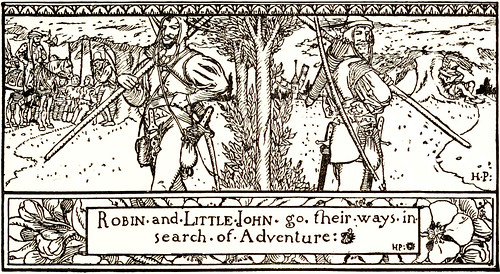 |
| https://www.flickr.com/photos/eoskins/6682273899/ |
The early rise of the Robin stories coincides with the narrowing of the financial gap between the lesser nobility and the commoners in England during the Hundred Years War. Various plagues, famines, and military conflicts had put a serious dent in the workforce, increasing the demand (and value) of labor. The nobles, whose vassals had died off, couldn't very well collect taxes from them were then doubly feeling the pinch. Nobles were also being regularly called upon to go to war on behalf of their king, which was not an inexpensive exercise (and they pass the taxes on to you, the commoners). When economic hierarchies break down, social change is in the wind.
Robin's portrayal as an archer is one of the few constants in all of his stories. Even if he can be bested with a sword or quarterstaff (and he was), he had no peer with the longbow. While archers had previously played a part on many battlefields around the world, the longbow did not come into full flower on the European battlefield until Falkirk (1298). It became the greatest weapon the English had in their wars against the French (and English laws did as much as possible to promote archery practice among the commoners, outlawing many games that interfered with valuable practice time). English archers were trained professionals on the battlefield, not impressed levies. The longbow overturned traditional hierarchies on the battlefield, by dropping those big expensive armored targets (and also slaughtering pikemen) at range. Defeating a knight on horseback took either another noble knight, a rank of pikemen, or a single skilled archer.
 |
| http://blog.histouries.co.uk/2010/10/12/ a-short-history-of-the-english-longbow/ |
Utilizing the longbow as the central image for a commoner who opposes the aristocracy seems pretty damn perfect. Long before the six-shooter became the image of the American western outlaw, the longbow was evening the odds in Sherwood Forest. The common people were becoming educated enough to recognize that they were being taken advantage of and began to dream of ways of fighting back. These feelings manifested in peasant revolts in both England and France on multiple occasions before the end of the Hundred Years War. Robin's longbow most certainly played a part.
References
general - http://www.boldoutlaw.com/robages/
robin hood wiki - http://en.wikipedia.org/wiki/Robin_Hood
history channel - http://www.history.com/topics/british-history/robin-hood
yeoman wiki- http://en.wikipedia.org/wiki/Yeoman
The Art of War in the Middle Ages Oman, C.W.C. (1885)
Longbow - http://blog.histouries.co.uk/2010/10/12/a-short-history-of-the-english-longbow/
